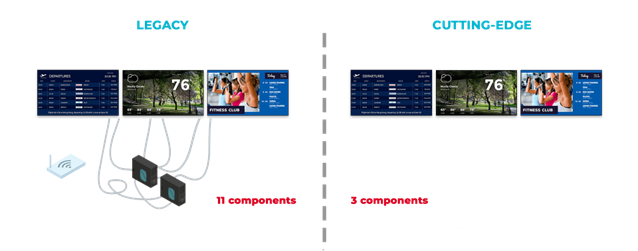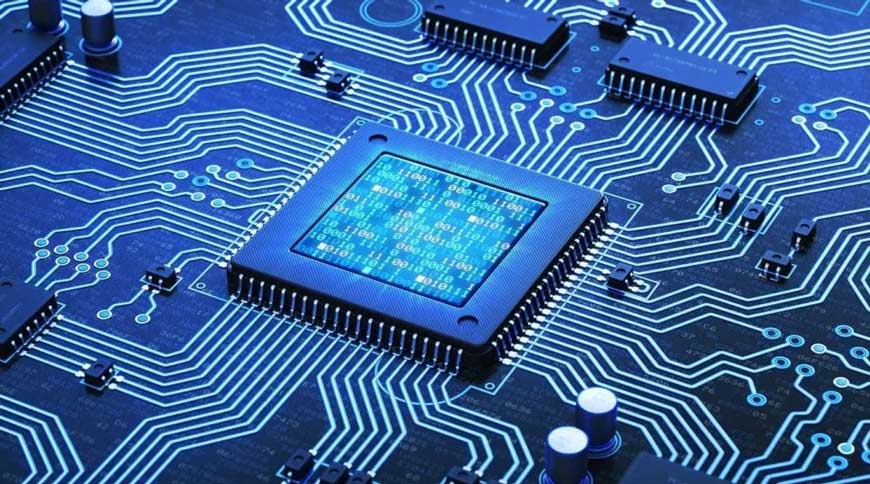What is an SoC (System on a Chip) Screen for Digital Signage?
What is System on a Chip (SOC)?
The acronym SoC refers to the term “System on a Chip”. System on a chip refers to a single electronic circuit board that combines various computer components onto a single integrated circuit or chip. These components are typically made up of a GPU, CPU and RAM among other things. Most system-on-chips today can be found inside of modern mobile devices like tablets and smartphones. So, obviously the use of SoC inside of professional grade displays has been rapidly growing over the past few years.
There is also a growing sentiment in the technology sector that SoC will, in the not too distant future, replace the traditional CPU in most devices. In short, think of a system on a chip as you would a miniature computer. It has all of the components needed for modern day computing, and comes in a fraction of the size. Perhaps the most well known true SoC / “computer on a chip” on the market today is the raspberry pi.
What is a SoC display?
A “system on a chip” or SoC screen means that inside of these types of displays, there is an embedded ‘chip’ that acts as the computer or media player. In terms of digital signage, SoC displays offer a complete ‘all-in-one’ solution because the screen itself is the only component you need to screen digital signage content. When using an SoC screen for digital signage, you won’t need a standalone player or to connect any other external devices or cables to the display. Simply mount the display, give it power and an internet connection (wired or wireless), install the digital signage software directly on the display, and go!
SoC displays have been rapidly gaining market share in the digital signage space over recent years, and we expect that to not only continue but accelerate. Today, SoC displays are being used in 41% of new digital signage deployments worldwide.
All top screen manufacturers now offer SoC displays for sale. You might be surprised to learn that they are often no more expensive than the same professional screen without the SoC built. Navori maintains close partnerships with the best SoC screen manufacturers including Samsung, LG, Philips, Sony, and more.
Why use SoC displays?
In short, cost savings and reliability.
The days of dominance of the external standalone player are coming to an end and for good reason. Compared to external media players, using a system on a chip will lower your overall CAPEX and OPEX by up to 48% on any digital signage deployment. How you may ask? The equation is simple, fewer components = less points of failure.
In a simple deployment of 3 digital signage displays your typical legacy setup would consist of 11 total components. This includes the displays, external media players, and all of the wires and cables you would need to make this work. Conversely, if you were to approach the same deployment but elected to use system-on-chip displays, you would only have 3 components. This leaner architecture improves reliability by a factor of 3 and provides real-time screen monitoring information inside Navori Content Manager.
If you consider the potential cost savings on hardware components, installation labor, and power consumption, the argument for using system-on-chip displays becomes crystal clear. Consider the graphic below:

Additional benefits of using SoC Displays
- Simplified installation: SOC displays eliminate the need for external media players or PCs, which can be cumbersome and require additional space and wiring. With everything integrated into the display, installation becomes much simpler and quicker.
- Reduced maintenance: With fewer components, SOC displays are less likely to experience technical issues, and troubleshooting becomes simpler. Additionally, updates and maintenance can be performed remotely, reducing the need for physical access to the display.
- Lower power consumption: Because SOC displays are designed for efficiency, they consume less power than traditional displays with separate media players or PCs. This not only saves energy, but also reduces operating costs over time.
- Improved reliability: SOC displays are designed specifically for digital signage applications, so they are typically more reliable and durable than consumer-grade displays. This is particularly important for businesses and organizations that rely on their digital signage to communicate with customers or employees.
- Increased flexibility: SOC displays are typically equipped with multiple inputs and outputs, allowing for greater flexibility in configuring and customizing the display. This can include support for multiple screen resolutions, video inputs, and networking options.
Which solution is right for me?
When making decisions about digital signage, organizations must weigh the pros and cons of SoC (System-on-Chip) displays versus external media players. On one hand, SoC displays offer convenience because they are all-in-one devices with built-in processors, memory, software, and hardware. This makes them ideal for straightforward applications that do not require a lot of customization. On the other hand, external media players are more versatile and offer more control over content and scheduling. These players can also be combined with multiple screens to create complex digital signage solutions.
Ultimately, the choice between SoC displays and external media players depends on the needs of the organization. Making the right choice can make all the difference in a successful digital signage strategy.
About Navori software and SoC
Navori Player is a professional and proprietary digital signage player software that renders content with the same features and performance across any hardware platform. This means you will have the same Navori features and performance when running content on an SoC display. Furthermore, you will not have to change your content management workflows or processes in order to use system-on-a-chip displays with Navori. In fact, you can even add SoC displays to your existing network of digital signage players and not have to make any changes to the way you work.
It is worth noting that Navori partners directly with the top SoC screen manufacturers in the world. We work closely and directly with each one in order to be able to deliver the best in class digital signage experience.
Not all system-on-a-chip displays are created equally. Thus we develop specifically to achieve the best possible performance on each brand’s SoC offering:

